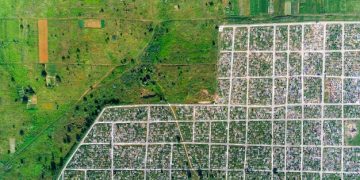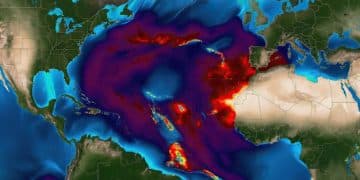Wildfire Risks 2025: Predictive Models & Evacuation
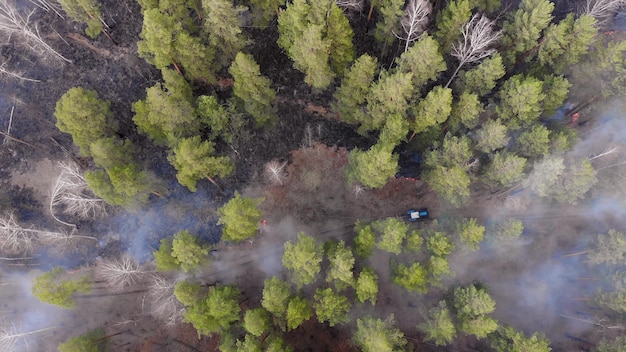
Predictive models and enhanced evacuation strategies for wildfire risks in 2025: new predictive models and evacuation strategies you need to know are crucial for mitigating the escalating threats posed by extreme weather, offering communities proactive tools to minimize destruction and ensure public safety.
As our planet grapples with increasingly unpredictable climates, the specter of wildfires looms larger than ever. Understanding the evolving landscape of wildfire risks in 2025: new predictive models and evacuation strategies you need to know is not merely academic; it is vital for community resilience and individual safety. This article delves into the cutting-edge advancements and practical approaches defining our preparedness for the fires of tomorrow.
Understanding the Evolving Wildfire Landscape
The nature of wildfires is fundamentally shifting. No longer confined to remote wilderness, these fires increasingly threaten urban fringes, driven by a complex interplay of climate change, land management practices, and human activity. The 2020s have already seen unprecedented fire seasons, leaving a trail of devastation across continents. Looking towards 2025, experts anticipate even more challenging conditions, necessitating a deeper understanding of the underlying factors.
One primary driver is prolonged drought, which desiccates vegetation, turning forests and grasslands into highly combustible fuel. Coupled with this are higher ambient temperatures, which extend fire seasons and intensify fire behavior. The urban-wildland interface (WUI), where human settlements meet undeveloped wildland, remains a critical vulnerability, presenting complex challenges for fire suppression and evacuation efforts.
The Impact of Climate Change
Climate change is arguably the most significant amplifier of wildfire risk. Rising global temperatures contribute to longer and more intense heatwaves, reducing fuel moisture and increasing the likelihood of ignition. Altered precipitation patterns mean some regions experience severe droughts, while others face erratic heavy rainfall that can lead to rapid vegetation growth, providing more fuel later. These shifts create a volatile environment, where traditional fire prevention methods may no longer suffice.
- Increased Aridity: Soil and vegetation dry out faster and more completely.
- Prolonged Fire Seasons: Fires are occurring earlier in spring and lasting later into fall.
- Extreme Fire Behavior: Leading to more intense, faster-spreading, and unpredictable fires.
Human Factors and Land Management
While natural phenomena play a role, human activities are responsible for a significant percentage of ignitions. Accidental ignitions from human sources like campfires, faulty equipment, and even discarded cigarettes remain a constant threat. Furthermore, decades of fire suppression policies, aimed at extinguishing all fires, have led to an accumulation of dense, flammable vegetation in many areas. This buildup creates a scenario where, once a fire starts, it can burn with extreme intensity, making containment exceedingly difficult. Prescribed burns and proactive fuel reduction are becoming increasingly critical land management tools.
Understanding these intertwined factors is the first step in building more resilient communities. The challenge lies not just in fighting fires, but in adapting to a new era where fire is an integral part of the landscape, requiring innovative solutions and community-wide engagement.
Advancements in Wildfire Predictive Models
The ability to predict where and when wildfires might occur, and how they might behave, is undergoing a revolutionary transformation. Traditional models, often relying on historical weather data and static fuel maps, are being augmented by sophisticated technologies that provide unprecedented accuracy and real-time insights. These new predictive models are critical for effective resource allocation and early warning systems.
One of the most significant leaps comes from the integration of artificial intelligence (AI) and machine learning (ML) with vast datasets. These systems can analyze complex variables simultaneously, from satellite imagery and atmospheric conditions to vegetation health and human activity patterns, identifying high-risk areas with remarkable precision. This allows fire management agencies to pre-position resources, issue timely warnings, and implement preventative measures before a fire even ignites.
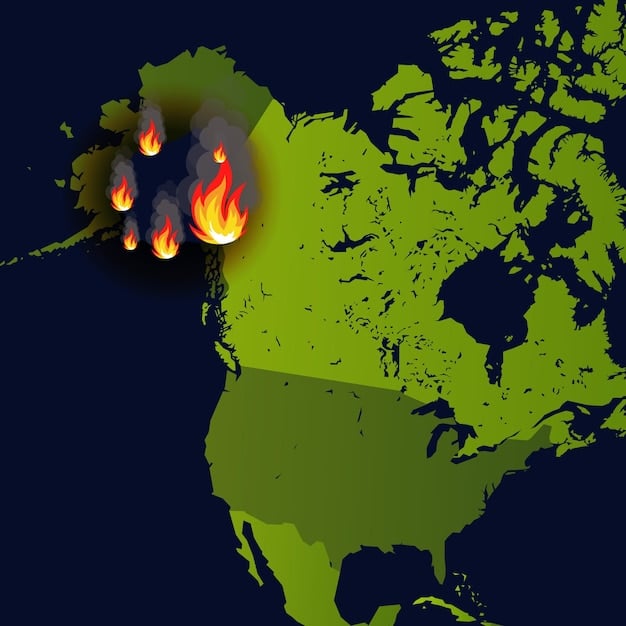
AI and Machine Learning for Forecasting
AI models are trained on historical fire data, weather patterns, topography, fuel types, and even social media sentiment to identify correlations and predict future fire behavior. These models can simulate fire spread under various scenarios, accounting for changing wind directions, fuel loads, and suppression efforts. Their ability to process massive amounts of data swiftly makes them invaluable for real-time decision-making.
- Early Anomaly Detection: Identifying subtle changes in vegetation or heat signatures indicative of potential ignition.
- Dynamic Fire Spread Modeling: Simulating fire advancement across complex terrains under varying atmospheric conditions.
- Resource Optimization: Recommending optimal deployment of firefighting personnel and equipment based on predicted fire behavior.
Satellite Imagery and Remote Sensing
High-resolution satellite imagery, coupled with advanced remote sensing technologies, provides a continuous stream of data on vegetation moisture, land cover changes, and “hot spots.” Thermal cameras mounted on drones and aircraft can detect nascent fires before they become visible to the human eye, offering critical early detection capabilities. These technologies allow for constant monitoring of vast, remote areas that are difficult to access by ground crews. The integration of this real-time data into predictive models significantly enhances their accuracy and responsiveness.
The sophistication of these new predictive models represents a paradigm shift in wildfire management. They transform our approach from reactive suppression to proactive prevention and strategic response, potentially saving lives, homes, and vast natural resources. However, the human element—interpretation and application of these insights—remains paramount for their effectiveness.
Enhanced Evacuation Strategies for 2025
While predictive models aim to prevent and mitigate fires, effective evacuation strategies are the last line of defense when a wildfire threatens communities. The lessons learned from past devastating fires have underscored the need for more dynamic, nuanced, and technologically-driven evacuation plans. For 2025, the focus is on leveraging communication tools, understanding human behavior, and creating flexible, community-specific protocols.
Traditional evacuation plans often rely on fixed routes and broad warnings. However, rapidly moving wildfires, coupled with unpredictable wind shifts, can render these plans obsolete in moments. New strategies prioritize real-time traffic management, multi-channel communication, and a deeper understanding of community demographics to ensure that everyone, especially vulnerable populations, receives timely and actionable information.
Real-Time Evacuation Route Optimization
Gone are the days of static evacuation maps. Modern strategies incorporate real-time traffic data, fire spread forecasts, and road closures to dynamically optimize evacuation routes. GPS-enabled apps and smart city infrastructure can guide residents to the safest and fastest exits, avoiding choked roadways or areas newly engulfed by flames. This adaptive approach is crucial for managing the chaos of a large-scale evacuation.
- Dynamic Routing: Adjusting pathways based on evolving fire movement and traffic congestion.
- Traffic Flow Management: Utilizing smart signals and signage to optimize vehicle movement.
- Contraflow Lanes: Reversing traffic direction on certain lanes to maximize outflow capacity during emergencies.
Multi-Channel Communication Systems
Reliable and redundant communication is paramount during an emergency. Relying solely on traditional sirens or door-to-door notifications is insufficient. Enhanced strategies involve a multi-channel approach, ensuring messages reach diverse populations through various mediums. This includes emergency alerts sent to mobile phones (WEA warnings), social media updates, local radio and TV broadcasts, public address systems, and even targeted phone calls for vulnerable residents. The key is to provide clear, consistent, and actionable instructions, avoiding panic while emphasizing urgency.
Effective evacuation is not just about having a plan; it’s about continuously refining it, testing it, and educating the public. It requires seamless coordination between emergency services, local government, and community leaders. As wildfire threats intensify, robust and adaptable evacuation strategies will be critical in minimizing casualties and protecting lives.
Community Resilience and Preparedness
The burden of wildfire preparation doesn’t rest solely on governmental agencies; community resilience is equally vital. Empowering residents with knowledge, tools, and a sense of collective responsibility can significantly bolster a region’s ability to withstand and recover from wildfire events. In 2025, the emphasis shifts from passive recipients of aid to active participants in their safety.
Building community resilience involves developing local emergency plans, establishing neighborhood watch programs for fire safety, and fostering a culture of preparedness. It also means investing in infrastructure that is inherently more fire-resistant and implementing land management practices at the local level that reduce fuel loads. Education plays a crucial role, ensuring residents understand the risks, know their evacuation routes, and have personal go-bags ready.
Defensible Space and Home Hardening
One of the most effective ways individuals can contribute to community resilience is by creating and maintaining defensible space around their homes and by hardening structures against embers. “Defensible space” refers to the area around a structure that has been managed to reduce fire risk, typically by clearing flammable vegetation. “Home hardening” involves using fire-resistant materials for roofs, siding, and decks, and sealing off potential entry points for embers. These measures significantly reduce the likelihood of a home igniting from passing wildfires.
- Vegetation Management: Clearing dry brush, excess foliage, and combustible materials within a certain radius of structures.
- Gutter Maintenance: Regularly clearing leaves and debris that can catch embers.
- Ember-Resistant Vents: Installing fine mesh screens to prevent embers from entering attic or crawl spaces.
Neighborhood Evacuation Drills and Plans
Theoretical knowledge is insufficient; practical experience is key. Regular community-wide evacuation drills, similar to earthquake or tornado drills, can familiarize residents with routes, assembly points, and communication protocols. Neighborhoods can also develop localized evacuation plans, accounting for specific vulnerabilities like dead-end streets or limited access points. These drills help identify bottlenecks, test communication systems, and build muscle memory for a chaotic situation. Furthermore, establishing clear roles and responsibilities for community members during an emergency can streamline response efforts.
A resilient community understands that wildfire preparedness is an ongoing process, requiring continuous education, adaptation, and collaboration. It’s a collective effort where every individual’s preparation strengthens the whole, ensuring a more effective response when fire strikes.
Technological Innovations in Fire Suppression
Beyond prediction and evacuation, the methods for actively suppressing wildfires are also undergoing significant technological transformation. While the bravery and dedication of firefighters remain indispensable, new tools and approaches are enhancing their effectiveness, increasing safety, and allowing for more targeted and efficient responses. These innovations aim to provide firefighters with better information, safer equipment, and more powerful means to combat the increasingly intense fires of the future.
From advanced drones providing aerial reconnaissance to sophisticated robotic systems assisting on the ground, technology is redefining fire suppression. The focus is not just on putting out fires, but on understanding their dynamics in real-time, anticipating their next move, and deploying resources strategically to achieve maximum impact with minimal risk to human lives.
Drones for Reconnaissance and Initial Attack
Unmanned Aerial Vehicles (UAVs), or drones, are rapidly becoming essential tools in wildfire management. Equipped with thermal imaging cameras, high-resolution visual cameras, and even infrared sensors, drones can provide real-time intelligence on fire perimeters, hot spots, and personnel locations, even through dense smoke. Larger drones are also being developed for initial attack, capable of dropping water or fire retardant on nascent fires in remote areas, before human crews can safely access them. Their ability to operate in hazardous conditions greatly enhances situational awareness and early response capabilities.
- Perimeter Mapping: Providing accurate, up-to-the-minute maps of fire boundaries.
- Hotspot Detection: Identifying smoldering areas that could reignite.
- Search and Rescue: Locating trapped individuals or injured firefighters.
Next-Generation Fire Retardants and Water Delivery
Innovations in chemical retardants and water delivery systems are also enhancing suppression efforts. Biodegradable fire retardants are being developed that are more environmentally friendly and effective at disrupting the combustion process. Furthermore, advancements in aerial firefighting platforms, from next-generation air tankers to precision water-dropping systems, allow for more accurate and efficient deployment of these agents. Even ground-based systems are seeing improvements, with advanced pumping and nozzle technologies that maximize water usage and firefighter safety.
These technological advancements, combined with the strategic insights from predictive models, are empowering firefighters with capabilities previously unimaginable. They are transforming the dangerous and arduous task of wildfire suppression into a more data-driven, precise, and ultimately safer endeavor, crucial for protecting communities and ecosystems.
Policy and Collaborative Frameworks for Wildfire Management
Beyond technology and individual preparedness, effective wildfire management in 2025 necessitates strong policy frameworks and robust collaborative efforts across multiple levels of government, private industry, and local communities. A piecemeal approach simply won’t suffice against a threat of this scale and complexity. The focus must be on integrated strategies that address the full lifecycle of wildfire risk, from prevention to recovery.
National, state, and local policies need to align to support proactive land management, strengthen building codes in high-risk areas, and ensure adequate funding for emergency services. Collaborative frameworks are essential for sharing resources, expertise, and data across jurisdictions, recognizing that fires do not respect administrative boundaries. This holistic approach ensures a more coordinated and effective response.
Cross-Jurisdictional Cooperation
Wildfires often span multiple jurisdictions—county lines, state borders, and even national boundaries. Effective response requires seamless cooperation among various fire departments, land management agencies, law enforcement, and emergency management organizations. Establishing pre-defined protocols for resource sharing, communication, and decision-making is critical. Mutual aid agreements, joint training exercises, and integrated command structures can significantly improve coordination during large-scale incidents. This cooperation extends to data sharing, allowing all entities to work from the same real-time intelligence.
- Shared Resource Pools: Enabling quick deployment of personnel and equipment across jurisdictions.
- Unified Command Systems: Streamlining decision-making during multi-agency responses.
- Data Interoperability: Ensuring seamless exchange of information between different systems and agencies.
Funding and Investment in Prevention
Historically, funding has often flowed disproportionately towards fire suppression rather than prevention. However, there’s a growing recognition that proactive investment in fuel reduction, prescribed burns, and fire-resistant infrastructure is far more cost-effective in the long run. Policies in 2025 are likely to emphasize increased funding for these preventative measures, alongside continued investment in advanced suppression technologies. Private sector involvement, through partnerships and innovative financing mechanisms, will also play a crucial role in scaling up these efforts. Encouraging private landowners to adopt fire-safe practices through incentives is also a key policy lever.
The future of wildfire management hinges on our ability to craft comprehensive policies and forge strong collaborations. By working together, from federal agencies to individual citizens, we can build a more resilient society that is better equipped to coexist with and adapt to the increasing threat of wildfires.
Addressing Psychological and Economic Impacts
The ramifications of wildfires extend far beyond the immediate physical destruction. The psychological toll on communities, individual mental health, and the broader economic landscape are profound and long-lasting. As we look to 2025, a holistic approach to wildfire management must encompass strategies for mitigating these less visible, but equally devastating, impacts. This means prioritizing mental health support, facilitating economic recovery, and rebuilding social cohesion in affected areas.
The trauma of displacement, loss of property, and uncertain futures can lead to significant stress, anxiety, and depression. Economically, wildfires destroy livelihoods, disrupt industries like tourism and agriculture, and can take years for local economies to recover. Understanding and proactively addressing these repercussions is crucial for true community resilience and sustainable recovery.
Mental Health Support and Community Healing
Experiencing a wildfire is a traumatic event. Providing immediate and long-term mental health support to survivors and first responders is paramount. This includes accessible counseling services, community support groups, and resources for coping with post-traumatic stress. Re-establishing social networks and community gatherings can also play a crucial role in collective healing, fostering a sense of shared experience and mutual support. Education on common stress responses following disaster can help individuals and communities navigate the recovery process more effectively, highlighting that it is normal to struggle and providing pathways to help.
- Trauma-Informed Care: Services designed to address the specific psychological impacts of disaster.
- Community Support Networks: Facilitating peer-to-peer support and shared recovery experiences.
- Long-Term Counseling: Ensuring continued access to mental health professionals for ongoing recovery needs.
Economic Recovery and Sustainable Rebuilding
The economic impact of wildfires can be crippling, particularly for small businesses and agricultural communities. Recovery strategies need to focus not just on rebuilding structures, but on revitalizing local economies. This can involve financial aid for businesses, job training programs for displaced workers, and initiatives to attract new investment. Furthermore, rebuilding efforts should emphasize sustainability and fire-resilience, ensuring that communities are not just restored, but made stronger and safer than before. This might include incentives for building with fire-resistant materials or for participating in local defensible space programs. Collaborative efforts between local governments, federal agencies, and non-profits are essential to facilitate rapid and equitable economic recovery, preventing long-term decline.
By proactively integrating psychological and economic recovery strategies into wildfire management plans, communities can emerge not only physically rebuilt, but also emotionally and financially stronger, better prepared to face future challenges.
| Key Point | Brief Description |
|---|---|
| 📊 Predictive Models | New AI/ML-driven models forecast wildfires with greater accuracy, aiding proactive resource deployment. |
| 🏠 Evacuation Strategies | Dynamic, real-time optimized routes and multi-channel communication ensure safer, faster evacuations. |
| 🏘️ Community Preparedness | Emphasis on defensible space, home hardening, and regular drills builds local resilience. |
| 🤝 Policy & Collaboration | Cross-jurisdictional cooperation and strategic funding for prevention are critical for integrated management. |
Frequently Asked Questions
New predictive models, leveraging AI, machine learning, and real-time satellite data, analyze complex variables like weather, fuel, and topography to forecast fire risks with unprecedented accuracy. This enables fire agencies to pre-position resources, issue early warnings, and implement preventative measures, moving from reactive suppression to proactive risk mitigation and strategic deployment.
Evacuation strategies for 2025 focus on dynamic route optimization using real-time traffic and fire spread data, multi-channel communication systems (alerts, social media, radio), and community-specific plans. The goal is to provide timely, clear, and actionable instructions to all residents, adapting to rapidly changing conditions and ensuring safe passage for vulnerable populations.
Individuals can create defensible space around their homes and harden structures using fire-resistant materials. Communities can build resilience through neighborhood evacuation drills, local emergency plans, and fostering a culture of preparedness. Collective action and education on fire-safe practices empower residents to actively participate in their own safety and contribute to broader community protection.
Technological innovations significantly enhance fire suppression by providing firefighters with better tools and information. Drones offer real-time reconnaissance, mapping fire perimeters and identifying hotspots, while some can even drop retardant for initial attack. Additionally, advancements in next-generation fire retardants and water delivery systems improve the efficiency and safety of active firefighting operations, allowing for more precise interventions.
A collaborative approach is essential because wildfires transcend jurisdictional boundaries and require coordinated efforts from federal, state, and local entities. Cross-jurisdictional cooperation, shared resource pools, and unified command systems ensure seamless response. Policies that prioritize prevention, coupled with private sector involvement and community engagement, create a holistic framework, fostering resilience and effective adaptation to escalating wildfire threats.
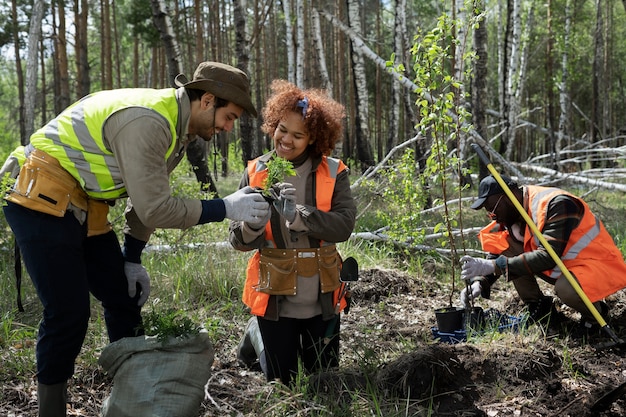
Conclusion: A Proactive Future for Wildfire Resilience
The escalating threat of wildfires demands a comprehensive and proactive approach, integrating cutting-edge technology with robust community engagement and policy frameworks. As we move into 2025, the focus on new predictive models, enhanced evacuation strategies, and strengthened community resilience is not merely aspirational; it is imperative. By leveraging artificial intelligence, remote sensing, and dynamic communication systems, we can gain unprecedented foresight into fire behavior and guide safer, more efficient responses. However, technology alone is not enough. The human element, encompassing individual preparedness, community collaboration, and thoughtful policy, remains the bedrock of true resilience. Investing in prevention, fostering a culture of shared responsibility, and committing to continuous learning will be crucial in mitigating the devastating impacts of wildfires, safeguarding lives, protecting property, and ensuring the long-term health of our vital ecosystems.



